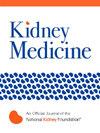CKD Prevalence and Incidence in Hispanic/Latino Adults Using Race-Free Estimated Glomerular Filtration Rate Equations
IF 3.4
Q1 UROLOGY & NEPHROLOGY
引用次数: 0
Abstract
Rationale & Objective
The impact of the race-free Chronic kidney disease Epidemiology Collaboration (CKD-EPI) 2021 estimating glomerular filtration rate equations (eGFR) on CKD prevalence and incidence in Hispanic/Latino adults is unknown. This study evaluated changes in CKD prevalence and incidence in Hispanic/Latino adults using race-free 2021 CKD-EPI equations.
Study Design
A prospective population-based cohort.
Setting & Participants
Estimates of CKD prevalence used data from 14,944 cohort participants. Incidence rates analyses used data from 9,038 participants who completed a visit ∼6 years following a baseline visit.
Analytical Approach
Prevalence of Kidney Disease Improving Global Outcomes eGFR categories and CKD (defined as eGFR < 60 mL/min per 1.73m2 or albuminuria-to-creatinine ratio [ACR] ≥ 30 mg/g) were compared using CKD-EPI 2009 and 2021 creatinine (cr)-based equations, and the 2012 and 2021 creatinine-cystatin C (cr-cys) equations. Reclassification across eGFR categories was estimated. Poisson regression was used to estimate rates of incident CKD (defined as eGFR < 60 mL/min/1.73m2 with eGFR decline > 1 mL/min/1.73m2 per year, or ACR ≥ 30 mg/g).
Results
The prevalence of eGFR > 90 mL/min/1.73m2 was higher using 2021 CKD-EPIcr than 2009 CKD-EPIcr (77.8 vs 72.1); 7.4% were classified to a higher (less severe) eGFR category. Prevalence of CKD was lower using 2021 CKD-EPIcr (10.5 vs 11.2%) and differences were more pronounced among those >55 years (20.5 vs 22.7%) and individuals of Puerto Rican background (13.8 vs 15.0%). Incidence rates were lower using the 2021 equation (9.2 vs 9.6 per 1,000 person-years) and differences were most prominent for those >55 years (20.1 vs 22.1 per 1,000 person-years). Similar findings were observed comparing eGFRcr-cys equations.
Limitations
The eGFR equations evaluated have not been validated in Hispanics/Latinos.
Conclusions
The 2021 CKD-EPI equations estimate lower CKD prevalence and incidence in US Hispanic/Latino adults, which has implications for public health and clinical practice.
Plain-Language Summary
The race-free Chronic kidney disease Epidemiology Collaboration CKD-EPI 2021 estimating glomerular filtration rate equations have been widely adopted into clinical practice. However, the impact of using these equations in the Hispanic/Latino population is not known. Therefore, using data from a study of almost 15,000 Hispanic/Latino patients, we evaluated the influence of these newer equations on estimates of prevalent CKD and new onset CKD. We found that the 2021 CKD-EPI estimated glomerular filtration rate equations resulted in lower estimates of CKD prevalence and lower estimates of new onset CKD in this population. These findings have implications for public health and clinical practice.
使用无种族估计肾小球滤过率方程的西班牙/拉丁裔成人CKD患病率和发病率
无种族慢性肾脏疾病流行病学合作(CKD- epi) 2021估算肾小球滤过率方程(eGFR)对西班牙/拉丁裔成人CKD患病率和发病率的影响尚不清楚。本研究使用2021年无种族CKD- epi方程评估了西班牙/拉丁裔成年人CKD患病率和发病率的变化。研究设计:前瞻性人群队列。背景和参与者:对CKD患病率的估计使用了14944名队列参与者的数据。发病率分析使用了9038名参与者的数据,这些参与者在基线随访后6年完成了随访。使用CKD- epi 2009年和2021年基于肌酐(cr)的方程,以及2012年和2021年基于肌酐-胱胺抑制素C (cr-cys)的方程,比较eGFR类别和CKD(定义为eGFR≤60 mL/min / 1.73m2或蛋白尿-肌酐比[ACR]≥30 mg/g)。估计跨eGFR类别的重新分类。泊松回归用于估计CKD发生率(定义为eGFR下降60 mL/min/1.73m2,每年eGFR下降1 mL/min/1.73m2,或ACR≥30 mg/g)。结果2021年CKD-EPIcr患者eGFR (90 mL/min/1.73m2)的患病率高于2009年CKD-EPIcr患者(77.8 vs 72.1);7.4%被归为eGFR较高(较轻)类别。使用2021 CKD- epicr, CKD患病率较低(10.5% vs 11.2%), 55岁(20.5% vs 22.7%)和波多黎各背景(13.8% vs 15.0%)的患者差异更为明显。使用2021年的公式,发病率较低(9.2 vs 9.6 / 1000人年),55岁的患者的差异最为显著(20.1 vs 22.1 / 1000人年)。比较eGFRcr-cys方程也观察到类似的结果。局限性:所评估的eGFR方程尚未在西班牙裔/拉丁裔人群中得到验证。2021年CKD- epi方程估计美国西班牙裔/拉丁裔成年人的CKD患病率和发病率较低,这对公共卫生和临床实践具有重要意义。无种族慢性肾脏病流行病学合作组织CKD-EPI 2021估算肾小球滤过率方程已被广泛应用于临床实践。然而,在西班牙裔/拉丁裔人群中使用这些方程的影响尚不清楚。因此,我们使用一项近15,000名西班牙/拉丁裔患者的研究数据,评估了这些新方程对估计流行CKD和新发CKD的影响。我们发现,2021 CKD- epi估计肾小球滤过率方程导致该人群中CKD患病率和新发CKD的估计值较低。这些发现对公共卫生和临床实践具有启示意义。
本文章由计算机程序翻译,如有差异,请以英文原文为准。
求助全文
约1分钟内获得全文
求助全文

 求助内容:
求助内容: 应助结果提醒方式:
应助结果提醒方式:


